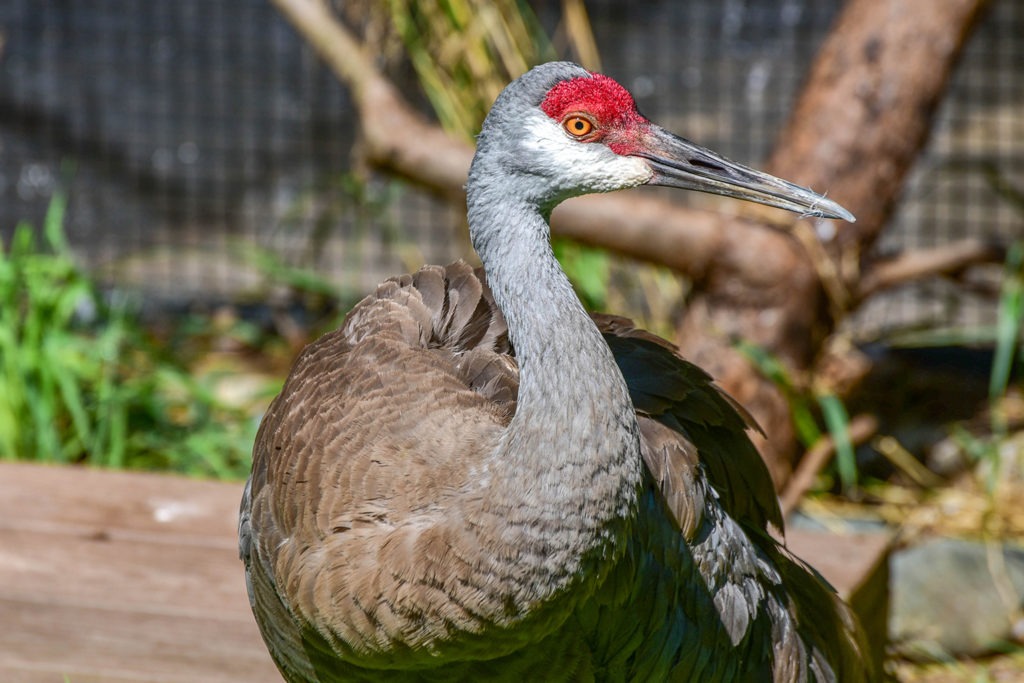Overview
“Where I live”
Most sandhill cranes migrate between northern breeding grounds in the U.S., Canada and Alaska and southern wintering grounds in the U.S. and northern Mexico. Three sub-populations of sandhill crane living in Mississippi, Florida, and Cuba respectively are known to be non-migratory. These large and elegant birds are always found near water in open grassland habitats.
“How I live there”
Sandhill cranes roost together in large groups at night and are active during the day. Most sandhill cranes leave the roost shortly after sunrise and return around sunset. They forage for food on land or in shallow marshes where aquatic plants grow out of the water. They also feed on insects, snails, lizards, frogs, small vertebrates, seeds, and berries. They use their bills to probe for food in soil and to break up larger pieces of food. Sandhill cranes can be seen tossing food high in the air and catching it far back in their bills, which allows for easier handling and swallowing.
“Making my mark”
Sandhill cranes love to “dance.” This “dancing” behavior includes bowing, jumping, running, calling, stick and grass tossing, and flapping of the wings. While dancing is an important courtship ritual, sandhill cranes and many other crane species are also known to dance outside of breeding season. Cranes of both sexes and all ages dance. It is thought that dancing helps with motor development and coordination, is a response to counteract aggression or relieve tension, and strengthens pair bonds.
“What eats me”
Healthy adult sandhill cranes are large and powerful birds that rarely suffer predation. They can fly away or stand their ground, hissing at and kicking any would-be attacker. For young, injured, or sick sandhill cranes, it’s a different story. They are vulnerable to many different predators, including foxes, wolves, coyotes, raccoons, bobcats, eagles, and owls.Sandhill cranes typically lay more than one egg as an “insurance policy” against chick fatality. Usually, only one chick per clutch survives.
Raising Young
Sandhill cranes are monogamous birds that mate for life. They form pair bonds at approximately 3 years of age during the winter season. The pairs then migrate together to breeding areas come spring. When establishing pair bonds, sandhill cranes perform a unison-call ceremony that consists of both the male and female crane standing still with their wings folded. The female initiates the ceremony by uttering one log, pulsing call, followed by a series of short calls synchronized with several longer calls by the male. The only movement during this display is the vertical head bobbing of the male.
Sandhill cranes usually nest in small, isolated wetlands that provide plenty of cover. They build large mound nests, on land or over water, using dried plant materials. Established pairs typically return to the same breeding site each year and will defend their nests vigorously. Male and female take turns incubating the eggs, which hatch after 29-34 days within one to two days of each other.
Chicks are able to leave the nest and swim as soon as 8 hours after hatching. Those that survive will spend their first 8-10 months with their parents. When a juvenile’s voice changes from a high-pitched “peep” to a louder and deeper call, it’s a sign that it will soon separate from its parents. At about 18 months, a young crane begins exhibiting adult-like social behavior, and pair bonding can occur from this point onward.
Conservation
Sandhill cranes are numerous and most populations are growing. For this reason, the species is listed as one of “least concern” by the IUCN, the world’s leading conservation organization. However, isolated populations of sandhill cranes in Cuba and Mississippi are considered endangered. The primary threat to all sandhill cranes is loss of wetlands habitat.
Taxonomy
- Kingdom: Animalia
- Phylum: Chordata
- Subphylum: Vertebrata
- Class: Aves
- Order: Gruiformes
- Family: Gruidae
- Genera: Antigone
- Species: canadensis


